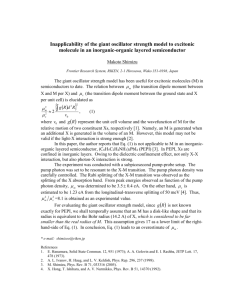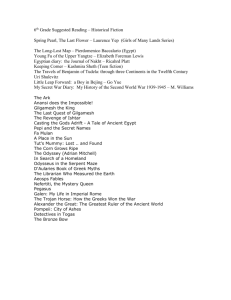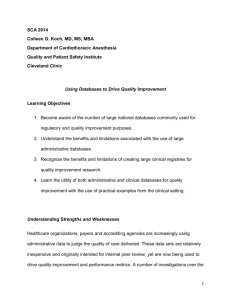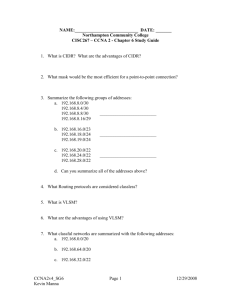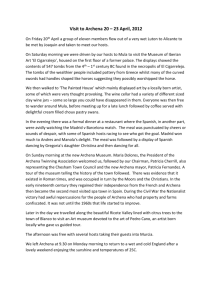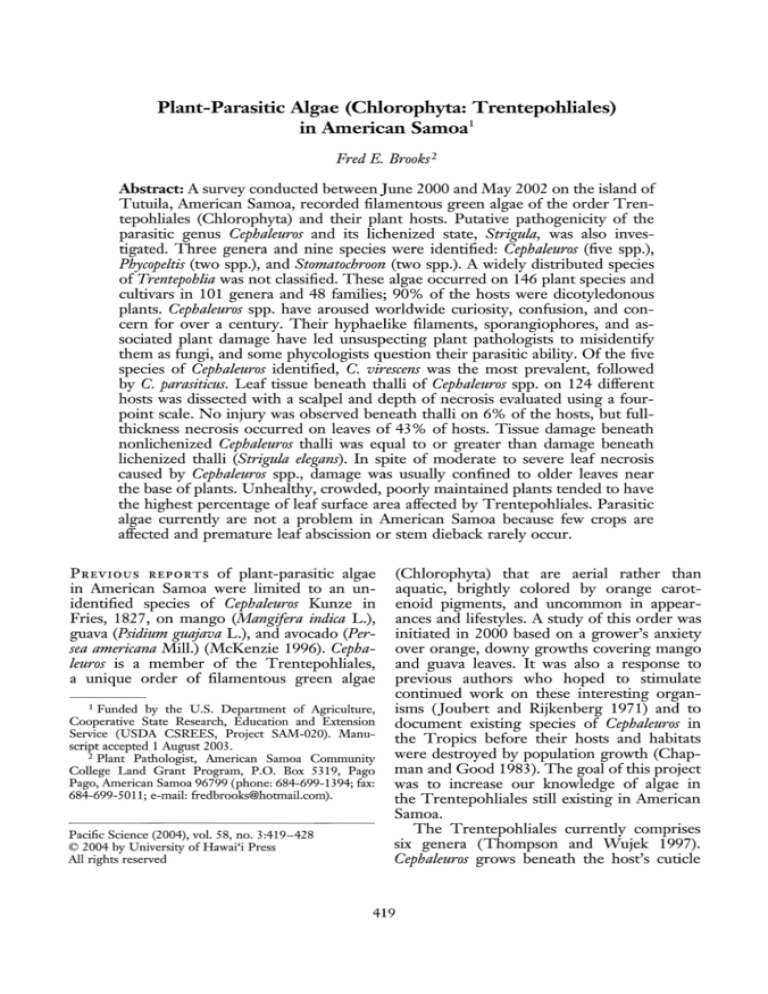
Plant-Parasitic Algae (Chlorophyta: Trentepohliales)
in American Samoa 1
Fnd E. Erooks 2
Abstract: A survey conducted between June 2000 and May 2002 on the island of
Tutuila, American Samoa, recorded filamentous green algae of the order Trentepohliales (CWorophyta) and their plant hosts. Putative pathogenicity of the
parasitic genus Cephaleuros and its lichenized state, Strig;ula, was also investigated. Three genera and nine species were identified: Cephaleuros (five spp.),
Phycopeltis (two spp.), and Stomatochroon (two spp.). A widely distributed species
of Trentepohlia was not classified. These algae occurred on 146 plant species and
cultivars in 101 genera and 48 families; 90% of the hosts were dicotyledonous
plants. Cephaleuros spp. have aroused worldwide curiosity, confusion, and concern for over a century. Their hyphaelike filaments, sporangiophores, and associated plant damage have led unsuspecting plant pathologists to misidentify
them as fungi, and some phycologists question their parasitic ability. Of the five
species of Cephaleuros identified, C. virescens was the most prevalent, followed
by C. parasiticus. Leaf tissue beneath thalli of Cephaleuros spp. on 124 different
hosts was dissected with a scalpel and depth of necrosis evaluated using a fourpoint scale. No injury was observed beneath thalli on 6% of the hosts, but fullthickness necrosis occurred on leaves of 43% of hosts. Tissue damage beneath
nonlichenized Cephaleuros thalli was equal to or greater than damage beneath
lichenized thalli (Strig;ula elegans). In spite of moderate to severe leaf necrosis
caused by Cephaleuros spp., damage was usually confined to older leaves near
the base of plants. Unhealthy, crowded, poorly maintained plants tended to have
the highest percentage of leaf surface area affected by TrentepoWiales. Parasitic
algae currently are not a problem in American Samoa because few crops are
affected and premature leaf abscission or stem dieback rarely occur.
PREVIOUS REPORTS of plant-parasitic algae
in American Samoa were limited to an unidentified species of Cephaleuros Kunze in
Fries, 1827, on mango (Mangifera indica L.),
guava (Psidium g;uajava L.), and avocado (Persea americana Mill.) (McKenzie 1996). Cephaleuros is a member of the Trentepohliales,
a unique order of filamentous green algae
I Funded by the U.S. Department of Agriculture,
Cooperative State Research, Education and Extension
Service (USDA CSREES, Project SAM-020). Manuscript accepted 1 August 2003.
2 Plant Pathologist, American Samoa Community
College Land Grant Program, P.O. Box 5319, Pago
Pago, American Samoa 96799 (phone: 684-699-1394; fax:
684-699-5011; e-mail: fredbrooks@hotmail.com).
Pacific Science (2004), vol. 58, no. 3:419-428
© 2004 by University of Hawai'i Press
All rights reserved
(Chlorophyta) that are aerial rather than
aquatic, brightly colored by orange carotenoid pigments, and uncommon in appearances and lifestyles. A study of this order was
initiated in 2000 based on a grower's anxiety
over orange, downy growths covering mango
and guava leaves. It was also a response to
previous authors who hoped to stimulate
continued work on these interesting organisms (Joubert and Rijkenberg 1971) and to
document existing species of Cephaleuros in
the Tropics before their hosts and habitats
were destroyed by population growth (Chapman and Good 1983). The goal of this project
was to increase our knowledge of algae in
the Trentepohliales still existing in American
Samoa.
The Trentepohliales currently comprises
six genera (Thompson and Wujek 1997).
Cephaleuros grows beneath the host's cuticle
419
420
and is considered an obligate epiphyte and
occasional parasite by some (Thompson and
Wujek 1997) and a plant pathogen by others
(Cunningham 1879, Marlatt and Alfieri
1981, Holcomb 1986, Holcomb et al. 1998).
Stomatochroon Palm, 1934, lives in the substomatal chambers of its host and was described as an "obligate endophyte (parasite)"
by Chapman and Good (1983) and a commensal organism by Timpano and Pearlmutter (1983). Phycopeltis Millardet, 1870, and
Physolinum Printz, 1921, are supracuticular
epiphytes but may be found on other surfaces under very humid or moist conditions
(Thompson and Wujek 1992, Davis and
Rands 1993, Rindi and Guiry 2002). The
free-living algae Trentepohlia Martius, 1817,
and Printzina Thompson & Wujek, 1992,
occur widely on living and nonliving substrates (Chapman 1984, Rindi and Guiry
2002, Thompson and Wujek 1992).
Few plant pathologists have the opportunity to identify plant-pathogenic Trentepohliales as causal agents of disease for several
reasons. First, these algae are found mainly
in tropical and subtropical climates (Chapman and Good 1983, Thompson and Wujek
1992). Second, though they have a broad
host range, their damage is often minimal and
the presence of a few small thalli on leaves
or stems may go unnoticed (Joubert and
Rijkenberg 1971, Holcomb 1986). Finally,
algae in this order are sometimes mistaken
for fungi due to their filamentous nature and
formation of setae, sporangiophores, and
zoospores (Cunningham 1879, Singh 1962,
Wellman 1965, Chapman 1984, Holcomb
and Henk 1984, Reynolds and Dunn 1984).
Misidentification is enhanced when fungi
invade these algae, forming lichens such as
Strigula and Raciborskiella (Santesson 1952,
Joubert and Rijkenberg 1971, Chapman and
Good 1983, Thompson and Wujek 1997).
Cephaleuros is the genus commonly linked
to plant damage (Joubert and Rijkenberg
1971, Marlatt and Alfieri 1981). Four of
the 13 most damaging species grow intercellularly: C. biolophus Thompson & Wujek,
C. minimus Karsten, C. parasiticlts Karsten,
and C. pilosa Thompson & Wujek (Thompson and Wujek 1997). The other nine spe-
PACIFIC SCIENCE· July 2004
cies, including C. virescens, grow beneath the
plant's cuticle but above the epidermis and
may cause little or no damage to the host.
Stomatochroon can cause incidental watersoaking of tissues but is not usually considered a plant parasite.
Cephaleuros virescens is the most frequently
reported algal pathogen of higher plants
worldwide and has the broadest host range
(Joubert and Rijkenberg 1971, Marlatt and
Alfieri 1981, Chapman and Good 1983, Holcomb 1986, Thompson and Wujek 1997). It
usually occurs on the upper leaf surfaces of
perennial dicotyledonous plants, but its thalli
occasionally are found on lower leaf surfaces and on monocots (Joubert and Rijkenberg 1971, Chapman and Good 1983).
The roughly circular thalli appear velvety due
to setae (sterile hairs) and sporangiophores
erupting through the host cuticle. The
hematochrome pigments astaxanthin and {3carotene (Thompson and Wujek 1997,
Lopez-Bautista et al. 2002) color the Trentepohliales yellow green to dark reddish orange, reportedly due to changes in light,
temperature, and available nutrients (Joubert
et al. 1975, Lorenz 1999).
The nonintercellular, subcuticular species
of Cephaleuros may not induce an obvious
response on some hosts (Chapman 1984,
Thompson and Wujek 1997). On other hosts,
however, cell death occurs beneath the algal
thallus (Thomas 1913, Joubert and Rijkenberg 1971, Chapman and Good 1983, Holcomb 1986). There may be tissue hyperplasia,
with or without the formation of suberin,
either below or at the margins of lesions
(Joubert and Rijkenberg 1971, Thompson
and Wujek 1997). Stem infections have been
implicated in twig death and branch dieback
(Ruehle 1936, Knoor 1964, Chapman and
Good 1983, Holcomb 1986, Holcomb et al.
1998) and algal spots on guava, avocado, and
citrus fruits may reduce their marketability
(Winston 1938, Ruehle 1941, Joubert and
Rijkenberg 1971, Chapman and Good 1983).
Reports have described Cephaleuros spp. as
causal agents of disease for over a century
(Cunningham 1879, Ruehle 1936, Winston
1938, Crandall and Davis 1944). Steps to
confirm its role as a plant pathogen (Koch's
Plant-Parasitic Algae in American Samoa . Brooks
421
postulates), however, have not been completed. This is probably due to the difficulty
in producing zoospores for reinoculation on
artificial media (Chapman and Good 1983,
Holcomb et al. 1998).
The objectives of this study were to identify existing species of Trentepohliales in
American Samoa and record their host range.
The emphasis of this report, however, is
on Cephaleuros spp. and their reputed role as
plant pathogens.
Two methods were used to estimate disease severity caused by Cephaleuros spp. First,
the most seriously affected host leaves were
assessed by estimating the percentage of their
upper leaf surfaces covered with algae: light
«5%), moderate (6-25%), or heavy (>25%).
Disease severity was also measured for mature
thalli from a nonrandom sample of hosts using a four-point necrosis index: (0) no necrosis; (1) superficial necrosis of the cell layer
beneath the algal thallus, with or without tissue hyperplasia; (2) necrosis of > 1 cell layer
but not full leaf thickness, with or without
tissue hyperplasia, erosion, or suberin formation; and (3) necrosis from upper to lower
leaf surface, including "shot-hole" symptoms.
Damage was assessed under a stereoscope by
dissecting fresh and dried lesions with a scalpel.
Lichens with mature fruiting bodies and
a species of Cephaleuros as the algal partner
were recorded and sent to a lichenologist (c.
Smith, University of Hawai'i) for identification. Tissue damage beneath lichen thalli was
assessed with the necrosis index and compared with damage by nonlichenized thalli on
the same host.
MATERIALS AND METHODS
Specimens were collected between June 2000
and May 2002 from a wide range of plant
species on Tutuila, main island of the U.S.
Territory of American Samoa. Tutuila is located at approximately 14° 18' S latitude and
170° 41' W longitude, has a mean annual
temperature of 26.4°C, and annual rainfall
from 2,500 mm at lower elevations to over
6,000 mm on Matafao Peak (660 m). Genera
of the Trentepohliales sometimes can be
identified in the field with a hand lens, but
all specimens were taken to the laboratory for
species determination by stereo- and light
microscopy. Several factors make species
identification difficult. The historical use of
RESULTS
different morphological characters to distinguish between species has led to incorrect Cephaleuros, Stomatochroon, Phycopeltis, and
descriptions (Thompson and Wujek 1997) Trentepohlia were collected on the island of
and a need to revise the order (Joubert and Tutuila during this study. The two remaining
Rijkenberg 1971; see also Lopez-Bautista et al. genera of the Trentepohliales, Printzina and
2002). Further, variability within and be- Physolinum, were not found. Algal species
tween species is possible due to season and identified and the number of plant hosts
exposure (Thompson and Wujek 1997). Spe- affected by each (in parentheses) were as folcies of Cephaleuros, Phycopeltis, and Stomato- lows: Cephaleuros expansa Thompson & Wuchroon were classified in this study based on jek (7), C. karstenii Schmidle (7), C. minimus
recently published keys and descriptions by Karsten (4), C. parasiticus Karsten (19), C.
Thompson and Wujek (1997). These char- virescens Kunze in Fries (115), Phycopeltis epiacteristics included morphology and location phyton Millardet (43), P. irreg;ularis (Schmidle)
of thalli and sporangiophores, measure- Wille (1), Stomatochroon coalitum Thompson
ments of central filament cells and their & Wujek (1), and S. consociatum Thompson
width-to-length ratio, and measurements of & Wujek (4). Specimens collected and not
gametangia and sporangia. Specimens are identified to species level included Cephaleuros
deposited in the Land Grant Herbarium, (16), Phycopeltis (4), and Trentepohlia (5). Four
American Samoa Community College, Ma- hosts of C. virescens remain unidentified.
laeimi. Hosts with only a few algal thalli were
There were similarities and differences
accessioned as semipermanent microscope between the five Cephaleuros spp. that aided in
slides and photomicrographs.
their classification. Thalli of C. expansa, C.
422
PACIFIC SCIENCE· July 2004
FIGURE 1. Subcuticular species of Cephaleuros removed from the upper leaf surface of hosts. A, Filaments of C. expansa
fusing to form a false ramulus (branch). B, Irregularly lobed thallus (body) of C. karstenii with multicellular, sterile
hairs. C, Entire, closed-ramulate thallus of C. virescens (note sporangiophore [right] with head cell and two sporangiatelaterals). Scale bars = 25 J.Im.
karstenii, and C. virescens grew beneath the
host cuticle and were more or less circular.
The thallus of C. expansa, however, was composed of radiating filaments that occasionally
crossed each other, or became laterally fused,
forming narrow, false ramuli (Figure IA).
Thalli of C. karstenii and C. virescens were either open- or closed-ramulate (Figure IB,C).
Ramuli of C. karstenii were four to six filaments wide and fan-shaped, and ramuli of
C. virescens were one to two filaments wide
and usually parallel. The width/length ratio
Plant-Parasitic Algae in American Samoa . Brooks
423
FIGURE 2. Sporangiophores of two intercellular species of Cephaleuros, with attached host tissue, excised frOID lower
leaf surfaces. A, Sporangiophores of C. parasiticus with terminal whorls of sporangiate-laterals. B, Sporangiophores of
C. minimus with sporangiate-laterals in twos and threes along one side, and ending in sterile, tapered cells. Scale
bars = 25 IlID.
of central filament cells was 1: 4 for C. karstenii and 1 :2 for C. virescens.
Cephaleuros parasiticus and C. minimus
formed scant, filamentous thalli beneath the
cuticle on upper leaf surfaces, grew intercellularly, and produced sporangiophores
through lower leaf surfaces. Sporangiophores
of C. parasiticus were typical for the genus,
composed of a terminal head cell with radiating sporangiate-laterals (crooked suffultory
cells and attached zoosporangia) (Figure 2A).
Conversely, sporangiophores of C. minimus
were unique, with head cells and sporangiatelaterals along one side and ending in two to
three tapered, sterile, apical cells (Figure 2B).
Trentepohliales were collected from 146
plant species and cultivars in 101 genera
and 48 families (Table 1). Ninety percent of
the hosts (129) were dicotyledonous species.
Most algae grew on leaves but were occasionally found on stems and fruit. Sapotaceae
was the most commonly affected family, with
14 host species and cultivars.
Percentage of leaf surface area covered
by Cephaleuros spp. varied by algal and plant
host species: 66% (109/165) of infections
were light, 25% (42/165) were moderate, and
9% (14/165) were heavy (Table 2). Because
of mixed infections (e.g., C. virescens and C.
parastttcus on the same plant), the number
assessed is greater than the total number of
plant species collected. Of the infections associated with C. virescens 29% (33/112) were
moderate and 9% (10/112) were heavy. Only
nine of the 145 hosts examined had moderate to heavy leaf area covered by the other
Trentepohliales, Phycopeltis, Stomatochroon,
and Trentepohlia.
Of 126 algal infections assessed with the
necrosis index, no visible tissue death or discoloration was caused by Cephaleuros spp. on
6% (8/126) of the hosts, 39% (48/126) scored
1, 12% (15/126) scored 2, and 43% (54/126)
scored 3 (Table 3). The number of algal infections assessed with the necrosis index was
less than either the number of hosts collected
or estimates for percentage leaf surface area
covered, because the necrosis index was initiated near the end of the study and some
host specimens were not available for sectioning.
Lichenized thalli of Cephaleuros spp. with
mature perithecia were found on 33 of 124
hosts and identified as Strigula elegans (c.
Smith, pers. comm.). Tissue damage caused
by S. elegans was less severe than (16/33) or
the same as (17/33) damage caused by the
alga alone. Recording lichenized forms of
424
PACIFIC SCIENCE· July 2004
TABLE 1
A List of Plant Hosts" of CephaleUl"OS, Phycopeltis, and Stomatochroon on Tutuila, American Samoa
Acanthaceae
Aphelandm sinclairiana Nees; Cvir
Odontonema tubiftrme (Bertoloni) Kuntze; Cvir
Pseuderanthemum carruthersii var. reticulatum (Seem.)
Guillaumin; Cvir
Agavaceae
Cordyline terminalis (L.) Chevallier; Csp
Pleomele sp. (Roxburgh) N. E. Brown; Pepi
Amaryllidaceae
Crinum asiaticum L.; Cexp
Anacardiaceae
Anacardium occidentale L.; Cvir+
Mangifem indica L.; Cvir, Cpar*, Scon
Annonaceae
Annona muricata L.; Cvir*
A. muricata 'Cuban Fiberless' L.; Cvir*
A. muricata 'Dulce Cuban' L.; Cvir
A. squamosa 'Seedless' L.; Cvir
A. squamosa x A. cherimoya 'Pink Mammoth' L.;
Cvir*, Cpar*
Rollinia deliciosa Saff.; Cvir+, Pepi, Scoa
Apocynaceae
Allamanda sp. L.; Cexp
A. cathartica L.; Cvir
Carissa grandifWra (E. Meyer) A. L. P. P. de Candolle;
Cvir
Araceae
Anthurium sp. Linden ex Andre; Cvir, Pepi
Epipremnum pinnatum (L.) Engler; Cexp, Cvir*
Araliaceae
Polyscias fruticosa (L.) Harms; Cvir*
P. scutellaria (N. L. Burman) Fosberg; Cvir
Arecaceae
Chrysalidocarpus lutescens H. Wendl.; Pepi
Metroxylon vitiense (H. Wendl.) HookJ.; Cvir, Psp
Pritchardia pacifica Seem. & H. Wendl.; Cvir, Pepi
Veitchia merrillii (Becc.) H. E. Moore; Cpar*, Pepi
Asclepiadaceae
Hoya australis R. Brown; Cvir, Pepi
Begoniaceae
Begonia sp.; Ckar
Bignoniaceae
Tabebuia heterophylla (DC.) Britton; Cvir
Bixaceae
Bixa orellana L.; Cpar*, Cvir
Bombacaceae
Cieba pentandra (L.) Gaer01.; Cvir
Durio zibethinus Moon; Cvir*, Pepi+
Pachira aquatica Aubl.; Cvir
Burseraceae
Canarium ovatum Engl.; Cvir
Clusiaceae
Calophyllum inophyllum L.; Cvir+
C. neo-ebudicum Guillaumin; Pepi
Combretaceae
Terminalia samoensis Rechinger; Cvir*
Convolvulaceae
Operculina turpethum (L.) Silva Manso; Csp
Cupressaceae
Cupressus sp. L.; Ckar
Ebenaceae
Diospyros samoensis A. Gray; Pepi
Euphorbiaceae
AleU17tes moluccana (L.) Willd.; Cvir*
Codiaeum variegatum (L.) A. H. L. Jussieu; Cvir*, Pepi
C. v. pictum 'Acubifolium' (L.) A. H. L. Jussieu; Cvir
C. v. pictum 'Majesticum' (L.) A. H. L. Jussieu; Cvir*,
Pepi
C. v. pictum 'Stewartii' (L.) A. H. L. Jussieu; Csp
Euphorbia neriiftlia L.; Cvir
Flueggea flexuosa Muell. Arg.; Cvir, Pepi
Jatropha integerrima Jacquin; Cvir, Pepi
Pedilanthus tithymaloides L.; Cvir*, Pepi
Fabaceae
Acacia sp.; Cvir, Csp, Pepi, Scon
A. mangium Willd.; Csp
Calliandra surinamensis Bentham.; Cvir
Cassia javanica L.; Cvir
Intsia bijuga (Colebr.) Kuntze; Ckar, Cvir+, Pepi
Pterocarpus indicus Willd.; Csp
Sophora tomentosa L.; Cvir
Heliconiaceae
Heliconia x 'Golden Torch' L.; Cpar
Lauraceae
Persea americana Miller; Cvir
Leeaceae
Leea guineensis G. Don; Cexp*, Cpar*, Cvir*, Csp*
Loganiaceae
Fagraea berteroana A. Gray ex Benth.; Cvir
Lythraceae
Cuphea melvilla Lindl.; Cpar*, Csp+, Scon
Lagerstroemia speciosa (L.) Pers.; Cmin*, Cpar*, Cvir*+,
Csp, Scon
Magnoliaceae
Michelia champaca L.; Ckar, Pepi
Malvaceae
Hibiscus rosa-sinensis L.; Cmin, Cvir, Csp, Pepi
H. tiliaceus L.; Cvir
H. tiliaceus cv. L.; Cvir
Marantaceae
Mamnta arundinacea 'Variegata' L.; Cpar*, Cvir, Pepi
Meliaceae
Lansium domesticum Correa; Cvir
Melia azedarach Blanco; Cvir, Psp
Swietenia macrophylla King; Ckar, Pepi
Moraceae
Artocarpus altilis (]. D. Hooker) Schlechter; Cvir
Ficus benghalensis L.; Cvir
F. benjamina L.; Cvir*
F. elastica Roxb. ex Hornem.; Cvir
F. prolixa Forst.f.; Cvir, Pepi
F. tinctoria ForstJ.; Cvir
Myrtaceae
Eugenia uniflom L.; Cvir*
Psidium guajava L.; Cvir*, Pepi
P. guajava 'Waikea' L.; Cpar*, Cvir+
Plant-Parasitic Algae in American Samoa . Brooks
425
TABLE 1 (continued)
Syzygium corynocarpum (A. Gray) C. Mue/I.; Cpar
S. inophylloides C. Muell.; Cpar
S. jambos (L.) Alston; Cvir*, Pepi
Nyctaginaceae
Bougainvillea spectabilis Willd.; Cvir
Oleaceae
Jasminum multiflorum (N. L. Burman) Andrews; Cvir,
Pepi
J. sambac (L.) Aiton; Cvir
Ligustrum sinense Lour.; Cvir, Pepi
Orchidaceae
Arachnis x maingayi (J. D. Hooker) Schlechter;
Cexp*+, Csp*, Pepi+
Arundina graminifolia (D. Don) Hochreutiner; Cexp*,
Cpar, Pepi
Spathoglottis plicata Blume; Csp
Unidentified epiphytic orchid; Pepi
Unidentified orchid; Cmin, Pepi
Oxalidaceae
Averrhoa carambola 'Jurong' L.; Cvir, Psp
A. carambola 'Kajang' L.; Cvir
A. carambola 'Kembangan' L.; Cvir
Pandanaceae
Pandanus whitmeeanus Mart.; Cvir, Pepi
Piperaceae
Piper graefJei Warb.; Csp*, Pepi
P. methysticum ForstJ.; Cvir
Polygonaceae
Homalocladium platycladium (F. Von Mueller) L. H.
Bailey; Cvir
Rubiaceae
Gardenia jasminoides 'Veitchii' Ellis; Cvir, Csp
G. taitensis A. L. P. P. de Candolle; Csp
Ixora casei Hance; Cvir
1. finlaysoniana Wallich ex G. Don; Cexp, Cvir
Morinda citrifolia L.; Cmin*
Mussaenda erythrophylla 'Rosea' Schumacher; Csp,
Pepi
M. frondosa Blanco; Cvir
M. philippica L. C. Richard; Cvir
Tarenna sambucina (ForstJ.) Durand; Cvir
Rutaceae
Citrus aurantifolia (L.) Swingle; Cvir
C. aurantifolia 'Thornless Mexican' L.; Csp
Murraya paniculata L. W. Jack; Cvir
Sapindaceae
Euphoria longan 'Bai Dum' (Lour.) Steud.; Cvir*
E. longan 'Chompoo' (Lour.) Steud.; Cvir
Litchi chinensis Sonn.; Cvir*
Pometia pinnata Forst.; Cvir, Pepi
Sapotaceae
Chrysophyllum cainito 'Grimal' L.; Cvir+, Pepi
C. cainito 'Hatian' L.; Cvir, Pepi
C. cainito 'Philippine Gold' L.; Cvir
C. cainito 'Seedless' L.; Ckar*
Lucuma mammosum (Jacq.) Merr.; Csp, Pepi+
L. nervosa 'Bruce' A. DC.; Csp*
Manilkara zapota 'Alano' (L.) D. Royen; Cvir*
M. zapota 'Betawi' (L.) D. Royen; Cvir*
M. zapota 'Ponderosa' (L.) D. Royen; Cpar*, Cvir*
Planchonella samoensis H. J. Lam ex Christoph.; Psp
Pouteria sapota (Jacq.) H. Moore & Stearn; Cpar*,
Cvir+, Pepi
Sandoricum koetjape 'Bangkok' Merrill.; Cpar*, Cvir
S. koetjape 'Chompoo' Merrill.; Cvir, Pepi
Synsepalum dulcificum (Schumach. & Thonn.) W. F.
Daniell; Cpar*, Cvir*
Solanaceae
Brunfelsia americana L.; Cvir*
B. pauciflora (Chamisso & Schlechtendal) Bentham;
Cvir
Cestrum diurnum L.; Cvir, Pepi, Scon
Sterculiaceae
Theobroma cacao L.; Cvir, Pepi, Pirr
Verbenaceae
Clerodendrum wallichii Merrill; Cvir, Pepi
C. x speciosum Van Geert ex Morren.; Cvir
Congea griffithiana Munir; Cvir
Faradaya amicorum Seem.; Cvir
Premna serratifolia L.; Cvir*
Zingiberaceae
Alpinia purpurata K. Schum.; Ckar
Note: The name of each host is followed by its authority, algal species (Csp, Cephaleuros sp.; Cexp, C. expansa; Ckar, C. kamenii;
Cmin, C. minimus; Cpar, C. parasiticus; Cvir, C. virescens; Psp, Phycopeltis sp.; Pepi, P. epiphyton; Pirr, P. i,ngularis; Scoa, Stomatochroon
coalitu"'; Scon, S. consociatum), and severity of disease (+, >25% of leaf area covered by the alga; *, full-thickness leaf necrosis) caused by
Cephaleuros spp.
"Table does not include unidentified hosts, except two orchid spp., nor hosts of T,·entepohlia.
the nonparasitic species Phycopeltis and Trentepohlia was outside the objectives of this
study.
DISCUSSION
Algae of the order Trentepohliales, especially
C. virescens and P. epiphyton, have a broad
plant host range in American Samoa (Table
1). Most of the hosts are perennial dicots,
agreeing with reports from other tropical
and subtropical locations (Marlatt and Alfieri
1981, Holcomb 1986, Thompson and Wujek
1997). However, the number of algal species
identified in American Samoa, especially the
five Cephaleuros spp., was higher than re-
PACIFIC SCIENCE· July 2004
426
of S. consociatum on the underside of leaves
of the firecracker plant (Cuphea sp.). Watersoaking and browning of tissue may occur
when sporangiophores of the alga block stomates and inhibit gas exchange (Chapman
No. Hosts Affected at Each
Level of Leaf Area Covered"
and Good 1983, Timpano and Pearlmutter
1983). This incidental damage might not
>25%
Alga
<5%
6-25%
qualify Stomatochroon as a plant pathogen, but
Cephaleuros expansa
6
it appears to be more than a space opportunC. karstenii
7
ist. The autotrophic S. consociatum, for examC. minimus
1
3
ple, was grown on an inorganic salts medium
C. parasiticus
12
4
3
by Timpano and Pearlmutter (1983), but all
C. virescens
69
33
10
stages of its life cycle could not be induced.
C. sp.
12
4
109
42
14
Total
Those researchers suggested that the alga receives necessary chemicals from its host but
"Some host leaf surfaces were infected by more than one
neither benefits nor harms the plant (comspecies of Cephaleuros.
b No hosts recorded for the algal species at this level.
mensalism).
McKenzie (1996) was probably correct
in suggesting that species of Trentepohliales
ported in many areas (Thompson and Wujek collected in American Samoa from mango,
1997). For example, Holcomb (1986) re- guava, and avocado were Cephaleuros virescens.
ported 218 plant hosts in Louisiana but only This was the most commonly identified speone algal species, C. virescens. Marlatt and cies in the current study and the most abunAlfieri (1981) did not identify the species of dant alga of the Trentepohliales found on
Cephaleuros found on 157 hosts in Florida.
these three trees species. Cephaleuros paraThe only plant damage associated with siticus, Phycopeltis epiphyton, and Stomatochroon
Stomatochroon spp. during this study was consociatum were also isolated from these hosts
water-soaking caused by a heavy infection (Table 1).
Thalli of C. virescens usually grow on upper leaf surfaces but were also common on
the undersides of heavily infected leaves.
TABLE 3
This
distribution was especially apparent
Host Leaf Damage Caused by Cephaleuros spp. on
when leaves were either twisted to expose
Tutuila, American Samoa, as Measured by a
their lower surfaces, had infections along
Necrosis Index"
their margins, or were split, with thalli surrounding the break on the upper leaf surface.
No. Hosts Affected at Each
Level of Necrosis b
These conditions favor infection of the lower
leaf surface by zoospores swimming in a film
2
Alga
o
of water connecting the two leaf surfaces
_c
Cephaleuros expansa
3
4 (Chapman and Good 1983). In a cumulative
1 study in Louisiana from 1972 to the midC. karstenii
4
2
C. minimus
2
14 1980s, Holcomb (1986) reported C. virescens
C. parasiticus
15
C. virescens
8
39
30 only on upper leaf surfaces of all hosts except
4
Camellia japonica, which had thalli on both
C. sp.
15
8
Total
48
55 surfaces.
Stem infections associated with C. virescens
n Necrosis index: 0, no necrosis; 1, superficial necrosis of
were rare in the current study, appearing only
the cell layer beneath the thallus, with or without tissue hyperplasia; 2, necrosis of > 1 cell layer but not full leaf thickness,
on kava (Piper methysticum) and the zigzag
with or without tissue hyperplasia, erosion, or suberization; 3,
plant (Pedilanthus tithymaloides). In the Louifull-thickness necrosis from upper to lower leaf surface, or "shothole" symptoms.
siana study (Holcomb 1986), however, 17
b Some hosts were infected by more than one species of
stem infections were reported, and recently
Cepbaletl1"os.
workers described cane infections on cultiNo hosts recorded for the algal species at this level.
TABLE 2
Percentage Upper Surface of Plant Host Leaves
Covered by Cephaleuros spp., Tutuila, American Samoa
C
Plant-Parasitic Algae in American Samoa . Brooks
427
vated blackberry in Arkansas and Louisiana
(Holcomb et a1. 1998).
Thompson and Wujek (1997) considered
C. virescens a "relatively innocuous" species,
causing obvious necrosis on only a few plant
hosts. They disagreed in general with published reports identifying C. virescens as a primary agent of disease. Thompson and Wujek
attributed the errors in those reports either:
(1) to misidentification of the alga, (2) to
the alga growing opportunistically in lesions
made by other organisms or environmental
conditions, (3) or to the fungal component of
the lichenized alga being the actual cause of
the damage. Results of the American Samoa
study differ from those of Thompson and
Wujek. Thalli of C. virescens usually occurred
in the absence of signs or symptoms of other
biotic agents or visible damage caused by the
environment. AB algae matured the diameter
of tissue necrosis mirrored thallus growth.
This relationship between the presence of an
algal thallus and host necrosis in the absence
of other lesion-forming organisms suggests
that C. virescens is a primary pathogen, able to
cause disease. Until plants can be inoculated
with zoospores of C. virescens and the same
symptoms produced (Koch's postulates),
however, its pathogenicity remains tentative
(Agrios 1997).
Damage caused by C. virescens on 33 plant
hosts in American Samoa was greater than
or equal to damage caused to the same hosts
by its lichenized form, Strigula elegans. This
observation argues against Thompson and
Wujek's contention (1997) that the fungal
partner of the lichen is the cause of disease,
but agrees with Chapman and Good's finding (1983) that necrosis beneath a lichenized
Cephaleuros thallus is produced by the alga
before lichenization. Ultrastructural studies
have shown that the fungus parasitizes its algal host and not the plant (Chapman 1976).
If a plant-pathogenic fungus were to associate
with C. virescens damage could occur (Chapman and Good 1983), but that was not the
case with S. elegans in this study.
Host tissue necrosis was present beneath
Cephaleuros thalli on over 90% of the 126
hosts indexed and was moderate to severe on
55% (Table 3). Comparatively, Holcomb
(1986) described moderately severe to severe
host responses, and leaf spotting, on only 8%
of 218 hosts. The terms moderately severe
and severe were not defined in the Louisiana
report, however, and may not be comparable
with the disease severity scales used in the
current study.
Tropical fruit trees in the Sapotaceae were
more heavily affected by Trentepohliales than
other plant families (Table 1). They had
the broadest host range, a moderate to heavy
percentage leaf area covered by the algae, and
full-thickness necrosis on many leaves. Most
specimens, however, were collected from
a crowded, poorly maintained fruit orchard
where heavy shading, lack of nutrients, and
high inoculum levels may have increased host
susceptibility. Control measures under these
conditions would include plant spacing and
thinning to improve aeration and light, optimum fertilization, orchard sanitation, and selecting cultivars for the local environment.
Algae in the order Trentepohliales remain a mystery to most American Samoans,
because plant-parasitic Cephaleuros species
do not affect important subsistence crops,
such as banana and taro. Occasional blemishes caused by algae on other types of produce and on landscape plants are tolerated.
Because control measures are not usually applied and most Trentepohliales have a broad
host range, their existence in American Samoa is relatively secure in spite of habitat
destruction due to population pressure and
natural disaster.
ACKNOWLEDGMENTS
My special thanks to D. Wujek for his
continued support, R. Chapman and his laboratory for their suggestions and encouragement, and O. C. Steele for assisting in plant
identifications.
Literature Cited
Agrios, G. N. 1997. Plant pathology. 4th ed.
Academic Press, New York.
Chapman, R. L. 1976. Ultrastructure of
Cephaleuros virescens (Chroolepidaceae;
Chlorophyta). 1. Scanning electron microscopy of zoosporangia. Am. J. Bot.
63:1060-1070.
428
- - - . 1984. An assessment of the current
state of our knowledge of the Trentepohliaceae. Pages 233-350 in D. E. G. Irvine and D. M. John, eds. Systematics of
the green algae. Syst. Assoc. Spec. Vol.
27.
Chapman, R. L., and B. H. Good. 1983.
Subaerial symbiotic green algae: Interactions with vascular plant hosts. Pages
173-204 in L. ]. Goff, ed. Algal symbiosis:
A continuum of interaction strategies.
Cambridge University Press, Cambridge.
Crandall, B. S., and W. C. Davis. 1944.
Cephaleuros virescens on chinchona in Central and South America. Plant Dis. Rep.
28:926.
Cunningham, D. D. 1879. On Mycoidea parasitica, a new genus of parasitic algae and
the part which it plays in the formation of
certain lichens. Linn. Soc. Trans. 1:301318.
Davis,]. S., and D. G. Rands. 1993. Observations on lichenized and free-living Physolinum (Chlorophyta, Trentepohliaceae).
]. Phycol. 29:819-825.
Holcomb, G. E. 1986. Hosts of the parasitic
alga Cephaleuros virescens in Louisiana and
new host records for the Continental
United States. Plant Dis. 70:1080-1083.
Holcomb, G. E., and M. C. Henk. 1984. Spot
of Magnolia grandiflora. Phytopathology
74:822.
Holcomb, G. E., S. R. Vann, and]. B. Buckley. 1998. First report of Cephaleuros virescens in Arkansas and its occurrence on
cultivated blackberry in Arkansas and
Louisiana. Plant Dis. 82:263.
Joubert,]. J., and F. H.]. Rijkenberg. 1971.
Parasitic green algae. Annu. Rev. Phytopathol. 9:45-64.
Joubert, ]. J., F. H. ]. Rijkenberg, and P. L.
Steyn. 1975. Studies on the physiology of
a parasitic green alga, Cephaleuros sp. Phytopathol. Z. 84:147-152.
Knorr, L. C. 1964. A suggestion that the Lee
tangerine may be hypersensitive to Cephaleuros virescens. Plant Dis. Rep. 48:478479.
Lopez-Bautista, ]. M., D. A. Waters, and
R L. Chapman. 2002. The Trentepohliales
revisited. Constancea 83 (1). http://ucjeps
PACIFIC SCIENCE· July 2004
.berkeley. edu/constancea/83/lopez_etal!
trentepohliales.html. Accessed 16 December 2002.
Lorenz, T. 1999. A technical review of
Haematococcus. http://www.eyanotech.com/
pdfs/axbul60.pdf. Accessed 27 December
2002.
Marlatt, R B., and S. A. Alfieri Jr. 1981.
Hosts of a parasitic alga, Cephaleuros
Kunze, in Florida. Plant Dis. 65:520-522.
McKenzie, E. H. C. 1996. Fungi, bacteria
and pathogenic algae on plants in American Samoa. Technical Paper 206. South
Pacific Commission, Noumea, New Caledonia.
Reynolds, D. R, and P. H. Dunn. 1984. A
fungus-like alga. Mycologia 76:719-721.
Rindi, F., and M. D. Guiry. 2002. Diversity,
life history, and ecology of Trentepohlia
and Printzina (Trentepohliales, Chlorophyta) in urban habitats in Western Ireland. ].
Phycol. 38:39-54.
Ruehle, G. D. 1936. An epiphytotic of algal
spot in South Florida. Plant Dis. Rep.
20:221-222.
- - . 1941. Algal leaf and fruit spot of
guava. Phytopathology 31:95-96.
Santesson, R 1952. Foliicolous lichens I: A
revision of the taxonomy of the obligately
foliicolous, lichenized fungi. Symb. Bot.
Ups. 12:1-590.
Singh, R N. 1962. A problematic filamentous
saprophytic alga. Am.]. Bot. 49:188-191.
Thomas, N. 1913. Notes on Cephaleuros.
Ann. Bot. (Lond.) 28:781-793.
Thompson, R H., and D. E. Wujek. 1992.
Printzina gen. nov. (Trentepohliaceae),
including a description of a new species. J.
Phycol. 28:232-237.
- - - . 1997. Trentepohliales: Cephaleuros,
Phycopeltis, and Stomatochroon: Morphology, taxonomy, and ecology. Science Publishers, Enfield, New Hampshire.
Timpano, P., and N. L. Pearlmutter. 1983.
Algal invasion of angiosperm mesophyll.
SEM Inc., AMF O'Hare, Chicago.
Wellman, F. L. 1965. Pathogenicity of Cephaleuros virescens in the Neotropics. Phytopathology 55:1082.
Winston, ]. R 1938. Algal fruit spot of orange. Phytopathology 28:283-286.

